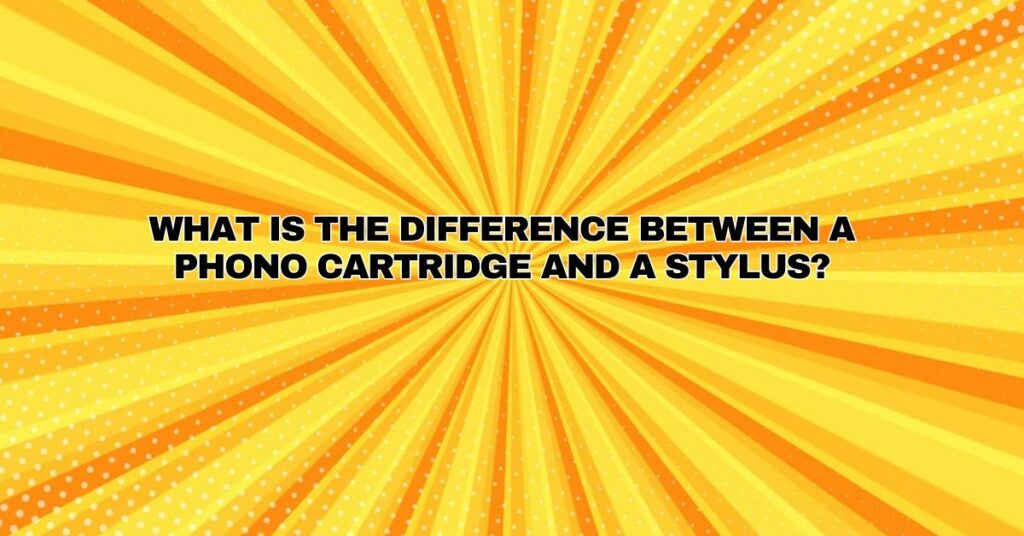In the world of analog audio and vinyl playback, there are several crucial components that work together to create the melodious sound that audiophiles cherish. Two of these integral elements are the phono cartridge and the stylus (also known as the needle). While they are often used interchangeably, it’s essential to understand that they serve distinct but interrelated functions in the vinyl playback process. In this comprehensive article, we will elucidate the key differences between a phono cartridge and a stylus, unraveling their roles and significance in the world of analog sound.
Phono Cartridge: The Heart of Vinyl Playback
A phono cartridge, commonly referred to as a cartridge, is the fundamental component responsible for converting the physical grooves of a vinyl record into electrical signals. Let’s delve into the defining characteristics and functions of a phono cartridge:
- Mechanical Component: The phono cartridge is a compact electro-mechanical device that is mounted onto the tonearm of a turntable. It contains several key components, including a stylus and a cantilever.
- Stylus Attachment: The stylus, a tiny and precision-crafted needle, is attached to the front of the cantilever. This stylus makes direct contact with the grooves on the vinyl record.
- Electromagnetic Conversion: As the vinyl record spins and the stylus moves through the grooves, it imparts vibrations to the cantilever. Within the cartridge, there is either a magnet or a coil of wire, depending on whether it’s a moving magnet (MM) or moving coil (MC) cartridge.
- Generation of Electrical Signals: These vibrations cause the magnet or coil to move, resulting in the induction of electrical currents through electromagnetic induction. The electrical signals produced are directly proportional to the physical movements of the stylus as it traces the grooves. These signals represent the original recorded sound on the vinyl.
- Output Terminals: The generated electrical signals are conveyed to the turntable’s output terminals, which may take the form of pins or a cable. From there, the signal is further amplified by a phono preamplifier and then sent to an amplifier or receiver to drive the speakers.
- Tonal Characteristics: Different cartridges possess unique tonal characteristics and sound signatures, making them suitable for various music genres and audiophile preferences. For instance, some cartridges are known for their warmth, neutrality, or specific sound profiles.
Stylus (Needle): The Precision Tracer of Grooves
The stylus, often referred to as the needle, is an essential subcomponent of the phono cartridge, serving as the point of direct contact with the grooves of the vinyl record. Understanding the stylus’s unique attributes and functions is crucial:
- Material and Design: Styluses are typically made from hard materials like diamond or sapphire, known for their durability and ability to withstand the rigors of tracing grooves. The stylus is crafted with a precision tip that is designed to smoothly navigate the intricate pathways etched into the vinyl surface.
- Cantilever Attachment: The stylus is mounted at the tip of a slender, flexible rod called the cantilever. This cantilever, in turn, is connected to the internal components of the phono cartridge.
- Mechanical Tracking: The primary function of the stylus is to physically trace the grooves of the vinyl record. As it moves through the grooves, the stylus undergoes minute vibrations, corresponding to the recorded sound, such as music or speech.
- Imparting Vibrations: These vibrations are transmitted to the cantilever, which is then linked to the magnet or coil inside the cartridge. The accuracy and precision of the stylus’s tracking are essential for faithful sound reproduction.
Key Differences: Phono Cartridge vs. Stylus
- Function: The phono cartridge serves as an electro-mechanical transducer responsible for converting the physical grooves of vinyl records into electrical signals, while the stylus is the component that physically traces these grooves.
- Mounting: The phono cartridge is mounted on the turntable’s tonearm, whereas the stylus is an integral part of the cartridge, attached to the cantilever.
- Electromagnetic Conversion: The cartridge is responsible for converting mechanical vibrations into electrical signals through electromagnetic induction, while the stylus is solely responsible for the mechanical tracking of the grooves.
- Tonal Characteristics: Cartridges are known for their specific tonal characteristics, influencing the overall sound profile, while the stylus is focused on the accuracy and precision of tracking.
Conclusion
In the intricate world of analog audio and vinyl playback, the phono cartridge and stylus play distinct but interdependent roles. The phono cartridge acts as the essential transducer that converts the grooves of vinyl records into electrical signals, while the stylus, as the precision tracer, physically navigates the grooves. These components work in harmony to recreate the magic of analog sound, offering audiophiles the timeless charm, warmth, and authenticity of vinyl records. Understanding the differences between a phono cartridge and a stylus is fundamental for anyone seeking to appreciate the nuances and intricacies of vinyl playback.


